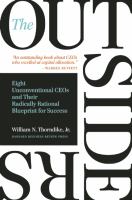I’ll recommend this book. Although it is becoming somewhat dated (copyright date was 2012), it gives the reader a 50,000 foot above the skies satellite view of some hand-picked CEOs that were able to strongly defeat the GE Jack Welch / S&P 500 record during multi-decade periods. They shared a single characteristic – they were able to allocate capital with discipline and ruthless efficiency. Operationally they were able to delegate to competent individuals and decentralization to the point of abdication was another theme.
If this book was written today and for Canadian CEOs, I would think Mark Leonard of Constellation Software (TSX: CSU) is an obvious candidate. He has delivered 42% compounded annual returns over the past decade, and 38% since going public in May of 2006 – notably still earning this return through the 2008-2009 economic crisis.
Reading (mostly written by) Mark Leonard’s Shareholder Q&A letters is fascinating insight on the company and how management thinks. It is indeed a shame that I never heard of this company until it was far, far too late. Sadly they are looking at future returns in the upper teens from their current size.
I have also taken great pleasure of reading Tyler’s compilation of quotations by TransForce’s (TSX: TFII) CEO Alain Bedard, which is a trucking and logistics company. TFII has performed at 22% compounded annually over the past decade, and about 13% since going public in October 2002 (in both cases dividend-adjusted). For a low margin business such as trucking, this is needless to say impressive.
There is a bit of retrospective bias in this book, however. Most individuals would probably regard Prem Watsa of Fairfax (TSX: FFH) as being a very good CEO, but his dividend-adjusted CAGR over the past decade has been 9%, and over the past 20 years has been 6%. Compare this with CEO Duncan Jackman of E-L Financial (TSX: ELF), which has been approx. 9% over both the past 10 and 20 year period. E-L Financial, in my opinion, is the least attention-seeking publicly traded corporation with a market cap of over a billion dollars.
For the sake of comparison, the TSX’s performance (dividends reinvested) over the past 10 years has been 6.6%. The main index (dividends not reinvested) over the past 17.7 years (which is how far the data goes back when they did a major change to the index) is 4.5% – adding in dividends would be another 3% or so. So a 9% CAGR performance is a slightly overperformance over the TSX, but posting returns into the teens and better is clear outperformance.

I always get a kick out of Thorndike, in an interview after the book was written, saying that he’d include Valeant’s Michael Pearson if he were to write the book again about current (at the time) CEOs, and also sort of comparing him to John Malone. Very much goes to show how much survivorship bias there is judging CEOs. There’s a reason he wrote about CEOs who were (mostly) finished in business.
To be fair to Thorndike, he also mentioned Mark Leonard.
Source: https://www.fool.com.au/2014/11/26/an-interview-with-the-outsiders-william-thorndike/